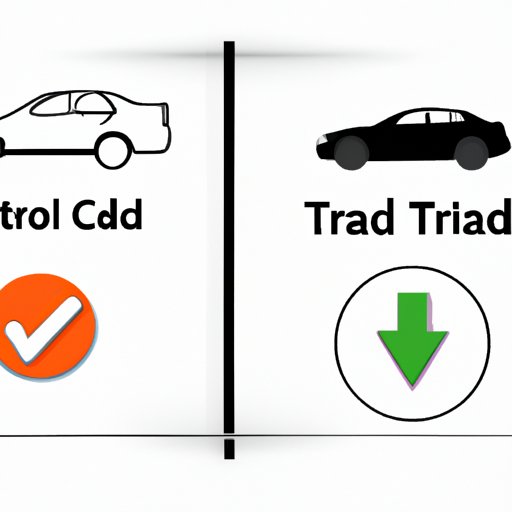
Introduction
Leasing a car is becoming a popular option for consumers who want to drive new cars without the long-term financial commitment of owning one. At some point in the lease, however, you may decide you no longer want or need the vehicle and wonder if you can trade it in. In this article, we’ll explore the pros, cons, and process of trading in a leased car.
Exploring the Pros and Cons of Trading in a Leased Car
When considering trading in a leased car, it’s essential to weigh the pros and cons. One advantage of trading in a leased car is that you can get out of the lease early, avoiding some of the fees and charges involved in keeping it until the end of the term. Still, there are drawbacks to consider, such as the potential financial consequences of ending a lease early and the possibility of not getting the best trade-in value.
Before deciding whether to trade in your leased car, consider your financial situation, your credit score, how much time is left on the lease term, and the car’s current value. Bear in mind the fact that ending your lease early might result in you having to pay early termination fees and extra charges.
Is It Worth It to Trade in Your Leased Car? Here’s What You Need to Know
Whether trading in your leased car is worth it will depend on several factors, including the car’s value, depreciation rate, and lease-end purchase price. When leasing a car, you’re paying for the depreciation the vehicle undergoes over the course of the lease term. The lease-end value, which is determined at the beginning of the lease, also plays a significant role in the trade-in value calculation.
To maximize the trade-in value of your leased car, keep it in good condition, take care of the routine maintenance and repairs, and stick to the lease terms. You can also negotiate with the dealership to get the best possible trade-in value and shop around to find the best offer for your vehicle.
Maximizing Trade-In Value: Tips for Those With a Leased Car
If you’re considering trading in your leased car, know that there are steps you can take to boost its value. One of the most important things is to keep your car well-maintained, as dealerships will factor its condition into the trade-in value. It’s also a good idea to research the current market value of your car and compare it with your lease-end purchase price.
Negotiating with your dealership and presenting them with evidence of your car’s value is an effective way to maximize the trade-in value. You can also consider trading in earlier than the lease term to avoid additional depreciation charges.
Understanding the Trade-In Process for a Leased Vehicle
The trade-in process for a leased car is not much different from that for a car you own. However, when trading in a leased car, the dealership will pay off your remaining lease balance and use the car’s trade-in value to determine any potential savings or additional charges. You will also need to make sure the car is in good condition and meets the lease terms to avoid any penalties.
When trading in your leased car, get some quotes from different dealerships to compare them. That way, you can determine the best trade-in value for your vehicle. And if you’re in a hurry to trade-in, make sure you have all the necessary documents ready to submit, such as proof of insurance and registration.
Why Trading in a Leased Car Makes Sense for Some Drivers
Although trading in a leased car has its disadvantages, it can also be a beneficial option for some drivers. For instance, if you have a new car in mind and want to upgrade, trading in your leased car can be a cost-effective way to do it. You can also save money on maintenance and repair costs by trading in your leased car earlier than the lease term. Real-life stories from people who have benefited from trading in their leased car can also be an inspiration that might help you decide if trading in your car is worth it.
The Hidden Costs of Trading in a Leased Car: What You Need to Consider
Before you decide to trade in your leased car, it’s crucial to consider the hidden costs, such as early termination fees and additional charges. Early termination fees can vary from one lender to another, but typically, they can amount to several thousand dollars. You can avoid these fees by trading in the car at the end of the lease term or finding someone to take over your lease.
You should also consider the costs involved in ending the lease early, such as excessive wear and tear, replacement of missing parts, and any lease modifications. It’s essential to weigh these costs against the potential benefits of trading in your leased car.
Conclusion
Trading in a leased car can be a smart move in some circumstances, but it’s essential to weigh the pros and cons carefully. Make sure you understand the trade-in process, shop around for the best trade-in value, and consider the potential hidden costs. By doing so, you’ll be in a better position to make an informed decision and avoid any surprises down the road.
Additional resources for readers interested in learning more about trading in a leased car:
- Asking the Right Questions When You Trade In Your Lease at NerdWallet
- How to Trade In a Lease Car and Get the Best Deal at The Simple Dollar
- How To Get The Best Trade-In Value and Maximize Your Returns at





